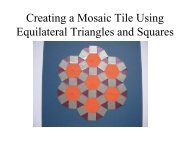OxfOrd flOrence in - Museum of the History of Science
OxfOrd flOrence in - Museum of the History of Science
OxfOrd flOrence in - Museum of the History of Science
Create successful ePaper yourself
Turn your PDF publications into a flip-book with our unique Google optimized e-Paper software.
Armillary Sphere<br />
Armillary Orrery<br />
Armillary Orrery<br />
Armillary Sphere<br />
Most armillary spheres follow <strong>the</strong> astronomical<br />
system <strong>of</strong> Ptolemy, with <strong>the</strong> earth<br />
stationary at <strong>the</strong> centre, while a few adopt<br />
<strong>the</strong> later Copernican arrangement, where<br />
<strong>the</strong> earth moves around <strong>the</strong> sun with <strong>the</strong><br />
o<strong>the</strong>r planets. This unique Italian armillary<br />
sphere is constructed accord<strong>in</strong>g to <strong>the</strong><br />
planetary system <strong>of</strong> Heracleides <strong>of</strong> Pontus,<br />
who lived <strong>in</strong> <strong>the</strong> 4th century B.C. Accord<strong>in</strong>g<br />
to this arrangement, Venus and Mercury<br />
revolve around <strong>the</strong> sun, while <strong>the</strong> moon,<br />
<strong>the</strong> sun, Mars, Jupiter and Saturn revolve<br />
around a central earth. In <strong>the</strong> seventeenth<br />
century this system was supported by <strong>the</strong><br />
Italian astronomer Andreas Argolus (1570-<br />
1650). Despite deal<strong>in</strong>g with such an ancient<br />
proposal, <strong>the</strong> armillary sphere is up-to-date<br />
<strong>in</strong> o<strong>the</strong>r respects. Jupiter is represented as<br />
hav<strong>in</strong>g four satellites and Saturn as hav<strong>in</strong>g<br />
three. While Galileo had discovered <strong>the</strong><br />
satellites <strong>of</strong> Jupiter, <strong>the</strong> third satellite <strong>of</strong><br />
Saturn was discovered <strong>in</strong> 1672 by Cass<strong>in</strong>i,<br />
who discovered <strong>the</strong> fourth <strong>in</strong> 1684. This<br />
suggests a date for <strong>the</strong> <strong>in</strong>strument between<br />
1672 and 1684. The horizon r<strong>in</strong>g carries <strong>the</strong><br />
name <strong>of</strong> Dom<strong>in</strong>icus Sanctes Sanct<strong>in</strong>i, who<br />
so far is not known as a maker <strong>of</strong> o<strong>the</strong>r <strong>in</strong>struments.<br />
Inventory no. 57517<br />
Richard Glynne was a maker <strong>of</strong><br />
ma<strong>the</strong>matical <strong>in</strong>struments, such as<br />
sundials and armillary spheres, who<br />
also sold maps at his shop <strong>in</strong> London,<br />
identified by <strong>the</strong> sign <strong>of</strong> ‘Atlas &<br />
Hercules’. He advertised ‘all K<strong>in</strong>ds <strong>of</strong><br />
Dials, Spheres and Globes <strong>of</strong> all Sizes.’<br />
The armillary orrery, dat<strong>in</strong>g from<br />
around 1720 and stand<strong>in</strong>g just over<br />
a metre <strong>in</strong> height, must have been at<br />
<strong>the</strong> top <strong>of</strong> his range: an impressive and<br />
expensive purchase by one <strong>of</strong> his most<br />
wealthy customers. It is an attempt<br />
to comb<strong>in</strong>e one <strong>of</strong> <strong>the</strong> oldest forms <strong>of</strong><br />
astronomical <strong>in</strong>strument, <strong>the</strong> armillary<br />
sphere, with what was <strong>the</strong>n one <strong>of</strong> <strong>the</strong><br />
most recent, <strong>the</strong> orrery or planetarium.<br />
The armillary sphere is <strong>the</strong> enclos<strong>in</strong>g<br />
outer part <strong>of</strong> <strong>the</strong> <strong>in</strong>strument, composed<br />
<strong>of</strong> r<strong>in</strong>gs represent<strong>in</strong>g <strong>the</strong> circles <strong>of</strong> <strong>the</strong><br />
celestial sphere, such as <strong>the</strong> equator,<br />
<strong>the</strong> tropics (Capricorn is miss<strong>in</strong>g)<br />
and <strong>the</strong> zodiac: it was best suited to<br />
illustrat<strong>in</strong>g <strong>the</strong> traditional Ptolemaic<br />
system with <strong>the</strong> earth stationary at <strong>the</strong><br />
centre <strong>of</strong> <strong>the</strong> cosmos and <strong>the</strong> heavens<br />
rotat<strong>in</strong>g around it. The celestial sphere<br />
rotates on an axis <strong>in</strong> this <strong>in</strong>strument<br />
but – somewhat <strong>in</strong>consistently – at<br />
<strong>the</strong> centre is a planetarium based on<br />
<strong>the</strong> Copernican system, where <strong>the</strong> sun<br />
is central and <strong>the</strong> earth both rotates on<br />
its axis daily and moves <strong>in</strong> an annual<br />
orbit. The earth and moon, Mercury<br />
and Venus are moved by wheelwork<br />
activated by a hand-crank, while<br />
Mars, Jupiter and Saturn are pushed<br />
round by hand. The drum at <strong>the</strong> north<br />
celestial pole has wheelwork mov<strong>in</strong>g<br />
<strong>the</strong> celestial sphere and a dial and<br />
hands for display<strong>in</strong>g <strong>the</strong> time.<br />
Inventory no. 57605<br />
Planetaria<br />
Pair <strong>of</strong> planetaria,<br />
Ptolemaic and Copernican<br />
Dat<strong>in</strong>g from around 1700, this is an unusual –<br />
perhaps unique – solution to <strong>the</strong> problem <strong>of</strong><br />
represent<strong>in</strong>g <strong>the</strong> cosmos by an <strong>in</strong>strument and<br />
accommodat<strong>in</strong>g both <strong>the</strong> traditional Ptolemaic<br />
arrangement, with <strong>the</strong> earth at <strong>the</strong> centre, and <strong>the</strong><br />
Copernican, where <strong>the</strong> earth is <strong>in</strong> orbit around <strong>the</strong><br />
sun, accompanied by <strong>the</strong> moon and rotat<strong>in</strong>g on<br />
its axis once a day. The two systems are treated<br />
<strong>in</strong> a pair <strong>of</strong> match<strong>in</strong>g <strong>in</strong>struments, which follow<br />
diagrams <strong>in</strong> J.C. Sturm’s Scientia Cosmica <strong>of</strong><br />
1670. Each planetarium has an outer r<strong>in</strong>g for <strong>the</strong><br />
zodiac and concentric r<strong>in</strong>gs for <strong>the</strong> planets, each<br />
carry<strong>in</strong>g a planetary symbol. S<strong>in</strong>ce <strong>the</strong> zodiac is<br />
horizontal, <strong>the</strong> earth – whe<strong>the</strong>r at <strong>the</strong> centre <strong>in</strong><br />
<strong>the</strong> Ptolemaic system or <strong>in</strong> orbit <strong>in</strong> <strong>the</strong> Copernican<br />
– is <strong>in</strong>cl<strong>in</strong>ed. The orbital r<strong>in</strong>gs, each carried by<br />
Grand Orrery<br />
Grand Orrery<br />
The partnership between Thomas Heath and his<br />
former apprentice Tycho W<strong>in</strong>g lasted from 1751<br />
to 1773, with premises at various addresses <strong>in</strong><br />
<strong>the</strong> Strand, London, and this is one <strong>of</strong> <strong>the</strong>ir most<br />
ambitious creations – a complete ‘grand orrery’<br />
with all <strong>the</strong> known planets and satellites fully<br />
driven by clockwork. The pendulum-regulated<br />
clockwork movement is beneath <strong>the</strong> base plate<br />
and it drives <strong>the</strong> planets out to Saturn with <strong>the</strong>ir<br />
respective periods, as well as <strong>the</strong> moon, four<br />
satellites <strong>of</strong> Jupiter (discovered by Galileo) and<br />
five <strong>of</strong> Saturn. The earth moves over a calendar<br />
scale giv<strong>in</strong>g <strong>the</strong> date. The glazed mahogany case<br />
is designed both to be appropriate to an elegant<br />
room and to reveal <strong>the</strong> wheelwork <strong>in</strong> addition<br />
to <strong>the</strong> planetary system – a clear sign that <strong>the</strong><br />
mechanism was meant to impress <strong>the</strong> viewer as<br />
well as <strong>the</strong> motions <strong>of</strong> <strong>the</strong> planets.<br />
Copernican Planetarium Inv. 19978<br />
Inventory no. 39896<br />
on loan from All Souls College, Oxford.<br />
four curved supports ris<strong>in</strong>g from <strong>the</strong> centre,<br />
can be rotated to represent movements and<br />
configurations <strong>of</strong> <strong>the</strong> planets; <strong>the</strong> exception<br />
is that <strong>in</strong> <strong>the</strong> Copernican <strong>in</strong>strument <strong>the</strong><br />
earth is carried by a tra<strong>in</strong> <strong>of</strong> three wheels,<br />
so that it rotates as it is moved around <strong>in</strong><br />
its orbit. In <strong>the</strong> Ptolemaic <strong>in</strong>strument <strong>the</strong><br />
symbols for Mercury and Venus, and for<br />
Saturn and Jupiter, are erroneously reversed,<br />
perhaps as <strong>the</strong> result <strong>of</strong> some subsequent<br />
repair. Although unsigned, it is likely that <strong>the</strong><br />
<strong>in</strong>struments were made <strong>in</strong> London by John<br />
Rowley.<br />
Inventory nos 68353, 19978;<br />
on loan from Christ Church, Oxford<br />
Ptolemaic Planetarium Inv. 68353


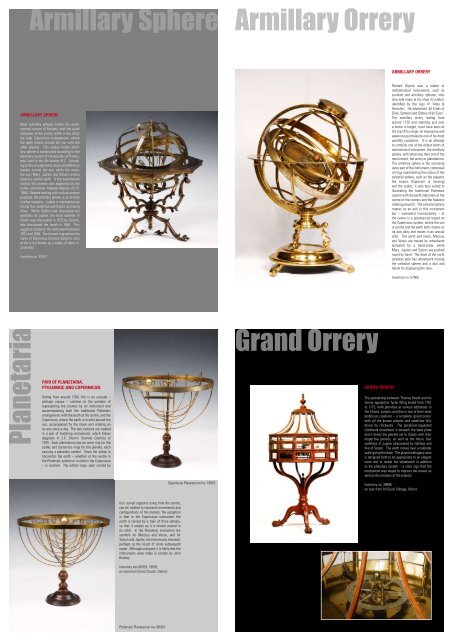
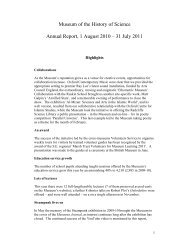
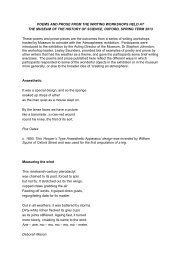

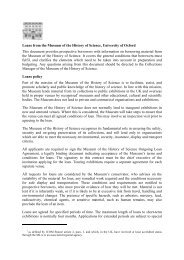
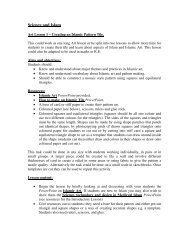
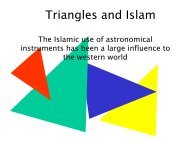
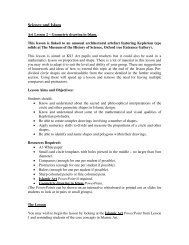
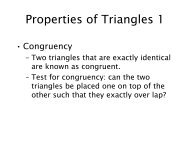

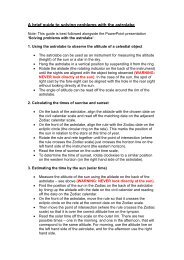
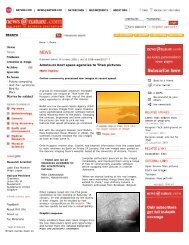
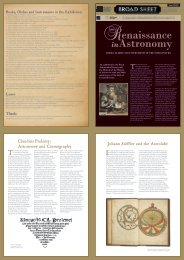
![Museum Guide and Plan [pdf] - Museum of the History of Science](https://img.yumpu.com/28054068/1/190x136/museum-guide-and-plan-pdf-museum-of-the-history-of-science.jpg?quality=85)
